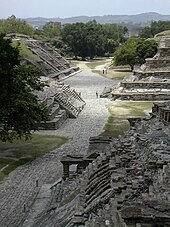
Back Класічная культура Веракрус Byelorussian Cultura del centro de Veracruz Spanish عصر کلاسیک وراکروز Persian Culture classique de Veracruz French Cultura classica di Veracruz Italian ვერაკრუსის კლასიკური კულტურა Georgian Cultura Veracruzensis Latin Veracruzcultuur Dutch Klassisk Veracruz NB Cultura Clássica de Veracruz Portuguese



Classic Veracruz culture (or Gulf Coast Classic culture) refers to a cultural area in the north and central areas of the present-day Mexican state of Veracruz, a culture that existed from roughly 100 to 1000 CE, or during the Classic era.[1]
El Tajin was the major center of Classic Veracruz culture; other notable settlements include Higueras, Zapotal, Cerro de las Mesas, Nopiloa, and Remojadas, the latter two important ceramics centers. The culture spanned the Gulf Coast between the Pánuco River on the north and the Papaloapan River on the south.
The Classic Veracruz culture is sometimes associated with the Totonacs, who were occupying this territory at the time of the Spanish Conquest of the Aztec Empire. However, there is little or no evidence that the Totonacs were the originators of the Classic era culture.[2]
- ^ Various authors give various end-points, e.g. Noble (p. 645) gives 250 CE to 900 CE while others vaguely refer to the MesoamericanClassic era, which itself spans different timeframes for different regions.
- ^ Coe, p. 115, who says "The tribal name 'Totonac' has often been inappropriately applied . . ." and Kubler, p. 137, who says "It is less misleading to refer to the region by chronological terms - Classic Veracruz and post-Classic - than by ethno-historical names [Totonac] of doubtful relevance."